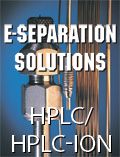Technology Forum: HPLC/ HPLC-Ion
With an IC instrumentation market forecast to grow more than 7% by 2012, ion chromatography is a thriving segment of the separation science industry. And with application in the areas of environmental, pharmaceutical, and agricultural research, this technique will find continued utility for years to come.

With the IC instrumentation market forecast to grow more than 7% by 2012, ion chromatography is a thriving segment of the separation science industry. And with application in the areas of environmental, pharmaceutical, and agricultural research, this technique will find continued utility for years to come.
Joining us for this discussion are Scott Anderson and Laura Kaepplinger of Grace Davison Discovery Sciences; and Jeff Rohrer of Dionex Corporation.
What impact has the acetonitrile shortage had on the use of HPLC/ HPLC-ion? Do you believe this impact will be lasting or is it temporary?
Anderson:We have found the shortage has driven HPLC users to look for creative solutions and alternatives to using acetonitrile. Modifying a method to use a different organic solvent, or replacing the acetonitrile portion of the mobile phase with a mixture of organic solvents has been a common and practical solution. There has also been increased interest in smaller column dimensions and adjustments to flow rate in order to minimize solvent consumption. The move to UHPLC to specifically address the acetonitrile shortage is less likely, but combined with the other benefits, can be justified. Currently, the demand for polymers, and thus, the acrylonitrile byproduct remains low. However, as economic conditions improve, and alternate means of producing and reclaiming acetonitrile are explored, we will see supply relief, albeit slow.
Rohrer:We believe the shift to faster methods and methods that use narrow bore columns to use less solvent will continue and that the acetonitrile shortage at least temporarily accelerated that trend. We do not believe people will continue to replace acetonitrile with other solvents.
What trends do you see emerging in HPLC and/or HPLC-ion?
Anderson and Kaepplinger:A major trend we see is the need for greater productivity. Chemists need to analyze more samples, generate more data to satisfy new requirements, and/or are pressured to save money by performing tasks faster. Similarly, there's a desire to reduce complexity and streamline processes by combining or removing steps. Consequently, we expect to see HPLC products and techniques that increase analysis speed or simplify workflow.
Rohrer:Faster and greener and all the tools that will make those things happen, monoliths, columns that require less or no organic solvent, more capillary and even nano LC for what are now routine standard bore applications, greater use of temperature, etc. More IC separations will use eluent generation and eluent regeneration.
What is the future of HPLC and/or HPLC-ion?
Anderson and Kaepplinger:We think the future will be towards products that ultimately deliver speed and a higher confidence in sample characterization. Products that produce equivalent results in less time, or continue to improve on resolution and selectivity should drive innovation. Smaller particles, novel chemistries, robust packings, and innovative hardware will likely be the focus of new product introductions and techniques.
Rohrer:Similar to the previous question. Methods will be faster and use less solvent. More separations will use more than one detector. More HPLC and IC separations will use a mass spec detector. HPLC and IC automation for control and data analysis will continue to increase in capability and easy of use.
What is the HPLC and/or HPLC-ion application area that you see growing the fastest?
Anderson and Kaepplinger:Additionally, biotechnology and proteomic definition are of particular interest. Greater understanding of protein interactions and structure seem to now be a part of all areas of life science. Whether part of a true biotechnology application, or used to better understand drug interactions with cell function and structure, proteomics is integral to expanding the life science knowledge base. In addition to gaining this knowledge, the more stringent regulatory requirements will drive the need for more resolution and better sensitivity in all areas of pharma.
Rohrer:While pharmaceutical applications are already very important, we believe that because of the drive to reduce health care costs with more generic drugs and treat conditions that now require hospitalization with a pharmaceutical, HPLC applications for this market will continue to grow at a rate higher than applications in other markets.
What is one change/improvement you hope to see in the HPLC/ HPLC-ion industry over the next few years?
Anderson and Kaepplinger:As more scientists adopt fast LC techniques, it has created a transition period where most labs have a variety of LC system types. The need to optimize and transfer methods quickly and easily between techniques becomes more important. Standardizing on a media platform that uses the identical base media and phase chemistries for sub-2 µm and larger particles can unify UHPLC, HPLC, and even preparative instruments. This will go a long way toward improving the overall laboratory efficiency and also help to streamline any R & D process.
Rohrer:We would like to see customers adopt methodologies that reduce the waste generated by LC analyses.
If you are interested in participating in any upcoming Technology Forums please contact Assistant Editor Meg Evans for more information.
Thermodynamic Insights into Organic Solvent Extraction for Chemical Analysis of Medical Devices
April 16th 2025A new study, published by a researcher from Chemical Characterization Solutions in Minnesota, explored a new approach for sample preparation for the chemical characterization of medical devices.
Sorbonne Researchers Develop Miniaturized GC Detector for VOC Analysis
April 16th 2025A team of scientists from the Paris university developed and optimized MAVERIC, a miniaturized and autonomous gas chromatography (GC) system coupled to a nano-gravimetric detector (NGD) based on a NEMS (nano-electromechanical-system) resonator.
Miniaturized GC–MS Method for BVOC Analysis of Spanish Trees
April 16th 2025University of Valladolid scientists used a miniaturized method for analyzing biogenic volatile organic compounds (BVOCs) emitted by tree species, using headspace solid-phase microextraction coupled with gas chromatography and quadrupole time-of-flight mass spectrometry (HS-SPME-GC–QTOF-MS) has been developed.
A Guide to (U)HPLC Column Selection for Protein Analysis
April 16th 2025Analytical scientists are faced with the task of finding the right column from an almost unmanageable range of products. This paper focuses on columns that enable protein analysis under native conditions through size exclusion, hydrophobic interaction, and ion exchange chromatography. It will highlight the different column characteristics—pore size, particle size, base matrices, column dimensions, ligands—and which questions will help decide which columns to use.








